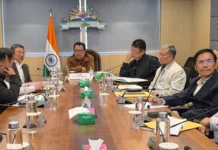[ Badak Yomgam ]
In the lush expanse of Arunachal Pradesh, where the Eastern Himalayas carve a striking landscape, the mighty rivers are far more than just waterways; they are the very arteries of rural life, increasingly becoming the ultimate source of the growing tourism industry that directly sustains countless livelihoods.
From the roaring rapids of the Siang to the serene stretches of the Subansiri, these rivers provide the foundational infrastructure for a unique brand of rural tourism. They nurture diverse settlements along their banks, fostering communities deeply intertwined with their aquatic environment. This natural connection now translates into tangible economic benefits for local populations.
By this transformation, direct employment is generated by river-based adventure tourism. White-water rafting, kayaking and angling expeditions are drawing adventurers, creating a demand for skilled local guides, safety experts and equipment operators. Villages with their intimate knowledge of the river’s moods and currents are perfectly positioned to fill these roles, transforming traditional wisdom into valuable services.
Beyond the thrill of adventure, the rivers facilitate a network of hospitality. Homestay and resorts are often run by local families in picturesque riverside villages, offering an authentic glimpse into Arunachal’s culture. These establishments provide much-needed accommodation and traditional meals, which directly empower households and practices. The demand for locally sourced produce to cater to tourists further strengthens the agricultural sector, creating a positive ripple effect throughout the local economy.
Furthermore, the very presence of tourists along these riverine routes stimulates a vibrant market for local handicrafts. Artisans, inspired by their natural surroundings and ancestral traditions, create unique souvenirs and crafts, offering visitors a tangible piece of Arunachal to take home. This provides a crucial supplementary income for many families, helping to diversify their economic base beyond traditional farming.
The success of river-based tourism also depends on the health and cleanliness of these vital waterways. Communities and organizations are increasingly recognizing the importance of environmental stewardship to ensure the long-term viability of river tourism and the well-being of local populations. A shining example of such dedication is the Youth Mission for Clean River’s (YMCR) consistent efforts to clean up the Yagamso river in Itanagar. Collaborating with students from Rajiv Gandhi University, local communities and NGOs, the YMCR regularly organizes mass cleanup drives, carefully segregating waste and conducting vital awareness campaigns on responsible waste management. These initiatives not only remove tonnes of debris but also instil a pristine environment for both residents and visitors.
The rivers of Arunachal are serving as catalysts for sustainable rural development. By harnessing their natural beauty and the rich cultural heritage of the communities living along their banks, a robust rural tourism ecosystem is emerging. This not only provides direct employment and diversified income opportunities but also encourages the preservation of indigenous knowledge and traditions, ensuring that the economic benefits flow directly back to the very people who call these river valleys home. The river, indeed, is proving to be the ultimate lifeline for rural livelihoods in Arunachal. (The contributor is a PhD scholar at NEHU, Shillong)



